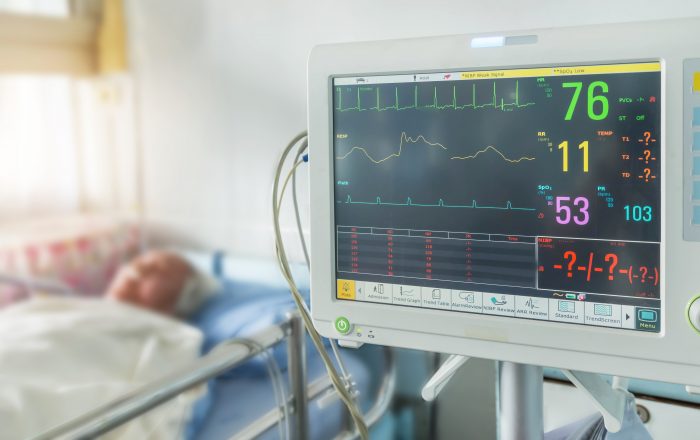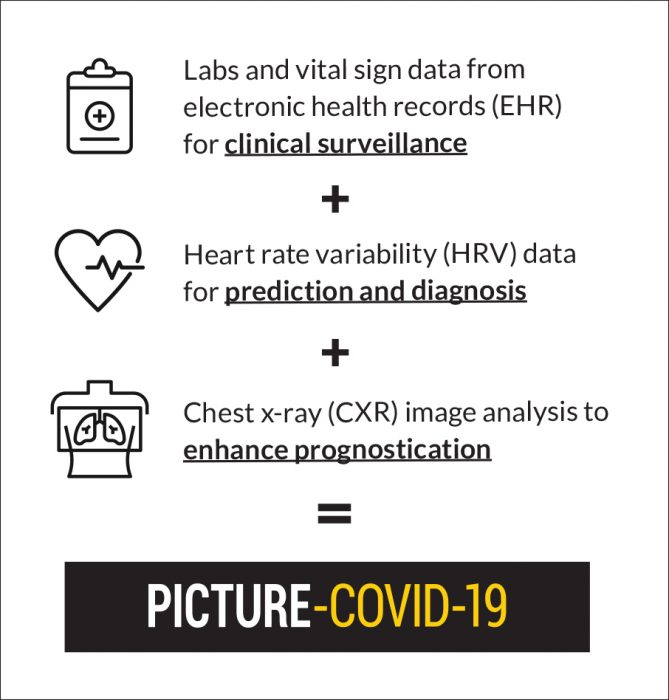
From the fight against the novel coronavirus to ICU transfer and patient rehabilitation, the Michigan Center for Integrative Research in Critical Care (MCIRCC) is developing intelligent prediction software to support health systems.
Technology is transforming every corner of the health care industry, including the way clinicians monitor patients. Current systems have demonstrated that early detection of patient deterioration can lead to reduced mortality risk, reduced length-of-stay, and decreased hospital costs, but early identification remains a challenge.
“One of the advantages of the electronic health record is having patient data immediately available,” said Dr. Richard Medlin, assistant professor of emergency medicine, associate chief medical information officer, and collaborator on the project. “Unfortunately, since this data is continually arriving for all patients on the unit, it can occupy all of a clinician’s time just keeping up with incoming data. On any given patient, it can take several minutes to summarize and interpret these individual data elements.”
To address this need, the Michigan Center for Integrative Research in Critical Care (MCIRCC) has developed PICTURE (Predicting Intensive Care Transfers and other Unforeseen Events), a machine learning algorithm utilizing electronic health record (EHR) data to continuously and accurately predict ICU transfer or death as a proxy for patient deterioration. Designed for seamless integration into any hospital, the customized algorithm crunches an array of data, such as vital signs, lab results, and demographic information, to flag the patients that are at highest risk of deterioration.
“PICTURE performs two tasks,” continued Dr. Medlin, “it summarizes all data and highlights important trends for any individual patient, and it can help clinicians prioritize which patient needs to be seen first.”
PICTURE’s robust algorithm also means the model will run successfully using lab results that are commonly available for a majority of patients, ensuring clinicians do not need to change their workflow or practices. The program will continue to make accurate predictions even if policy changes are put in place that alter which tests are routinely ordered.
“PICTURE is designed to help catch deterioration events before they happen, and to provide alerts which are helpful and clinically actionable,” said Brandon Cummings, a data scientist at MCIRCC.
In addition to predicting deterioration, PICTURE also provides an explanation of the main factors contributing to its prediction. This transparency can help clinicians to quickly verify the urgency and accuracy of an alarm, which can help guide decisions around patient care, as well as mitigate alarm fatigue. The need for such systematized technology in health care has increased in recent decades, as an array of monitoring devices produces tens of thousands of alarms on a daily basis. The vast majority of alarms from these devices do not require a clinical response, which makes it harder for nurses and doctors to pick out the rare ones that do. Furthermore, existing systems that quantify patient risk have been known to raise several false alarms. PICTURE harnesses machine learning to more accurately predict patient deterioration with fewer false alarms than any system currently available.
“PICTURE saves time and helps clinicians pick up important trends in a timely fashion,” said Dr. Medlin.
PICTURE-REHAB
The Michigan Medicine Inpatient Rehabilitation Unit was experiencing a rate of readmission back to acute care that was higher than the national average. While patients on this unit are admitted in a medically stable condition necessary for rehab, sometimes their health suddenly deteriorates to the point of needing to be readmitted to acute care for medical management. This disrupts the patient’s rehabilitation course of care and can take a psychological toll on the patient themselves. To help reduce these rates, the Inpatient Rehab team was searching for a solution to predict potential patient readmissions by catching patient deterioration in its earliest stages.
They met with the MCIRCC Data Team and started the collaborative work of defining requirements for a modified version of the PICTURE predictive analytic that would alert clinicians to patient deterioration in the rehab unit prior to any observable symptoms. The specialized application also features MiChart integration and single sign-on, allowing seamless access for clinicians.
“PICTURE is basically an early warning system,” said Dr. Joshua Startup, a clinical lecturer in physical medicine and rehabilitation at U-M. “The goal is to alert providers early in a patient’s deterioration so that they may provide earlier intervention. The sooner that a physician is alerted, the earlier that they can intervene.”
With support from Health Information Technology & Services (HITS), PICTURE was deployed in the Inpatient Rehab Unit on September 4, 2019, for an initial three-month feasibility quality improvement pilot. In that time, the feedback received from clinicians was favorable and indicated that the model was providing useful alerts. Currently the team is gearing up for a randomized controlled trial to assess PICTURE’s ability to lower the overall readmission rate.
“We are hopeful of the potential of PICTURE to reduce readmissions based on the work that was done in our feasibility testing,” noted Dr. Startup.
PICTURE-COVID-19
ICU triage decisions, outcomes management, and capacity planning for hospitals has become a critical issue with the influx of patients with COVID-19 symptoms. Though commonly known for its respiratory complications, symptoms can affect the entire body and patients can deteriorate quickly as their immune systems work in overtime to combat the disease. If health care teams can intervene early, they may be able to prevent critical deterioration for these patients. In addition to the danger for patients, COVID-19 is also highly transmissible, and treating it puts caregivers at great risk of contracting the disease themselves. As a result, there is an urgent need for a deployable solution capable of identifying patients who are at the greatest risk of deterioration while also conserving personal protective equipment and other critical hospital resources.
In response to the COVID-19 health crisis, the MCIRCC Data Science Team made a quick but smooth pivot, rapidly adapting research and lessons learned from other critical illnesses to develop an enhanced version of the PICTURE platform. The aim with PICTURE-COVID-19 is to combine three analytical approaches to create a powerful diagnostic and surveillance system tuned specifically for COVID-19 patients. This version of PICTURE will look at specific data points, including labs, continuous ECG waveform analysis, and automated chest x-ray imaging analysis, in real time, to predict patients who may need more intensive care support.

“An incredible challenge with COVID-19 has been the wide variation in how patients respond to the virus, making it difficult to know where to focus our attention as clinicians in order to be as helpful as we can,” said Dr. Andrew Admon, Clinical Lecturer in Pulmonary and Critical Care Medicine at U-M and a collaborator on the PICTURE-COVID-19 project. “By allowing us to stay a step ahead of COVID, the results of this work will allow us to identify patients who are at high risk for some of COVID’s most serious complications.”
In May 2020, PICTURE-COVID-19 received a funding award from the Michigan Institute for Data Science (MIDAS) as part of the Propelling Original Data Science (PODS) pilot funding program. Chosen out of 49 applicants, the team received funding to further its research to ‘combat the pandemic in varied and creative ways.’ The award description goes on to note, “These projects…demonstrate the resolve, expertise and creativity of U-M data scientists facing a public health catastrophe. They lend us hope that science will help us prevail.”
Dr. Kevin Ward, Executive Director for MCIRCC, said, “The PICTURE product line is another great example of MCIRCC using multidisciplinary innovation and integration to develop scalable platforms that span the spectrum of critical illness and injury.”
Additional PICTURE products are in various stages of development – including specific PICTURE analytics for adult and pediatric sepsis.

